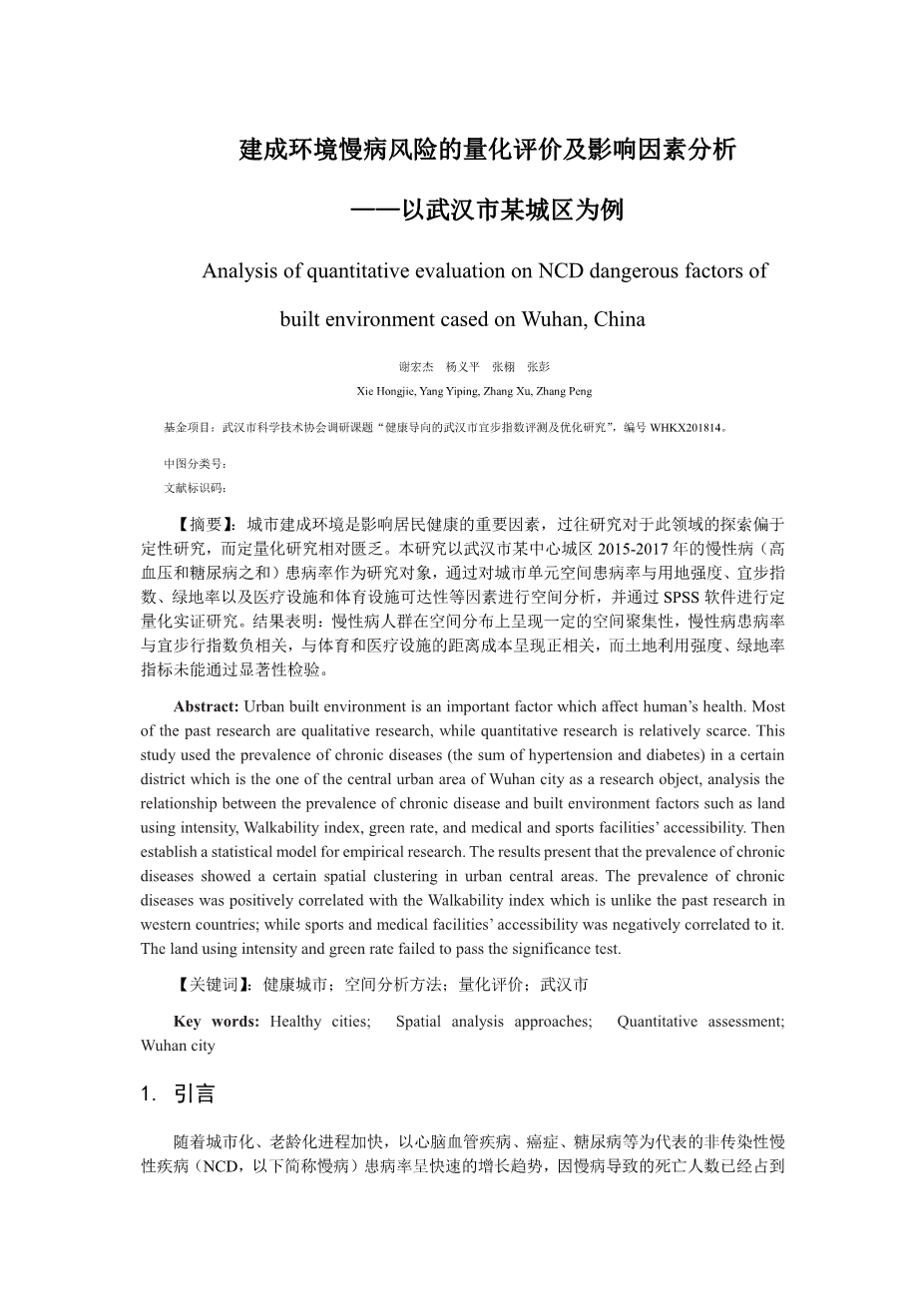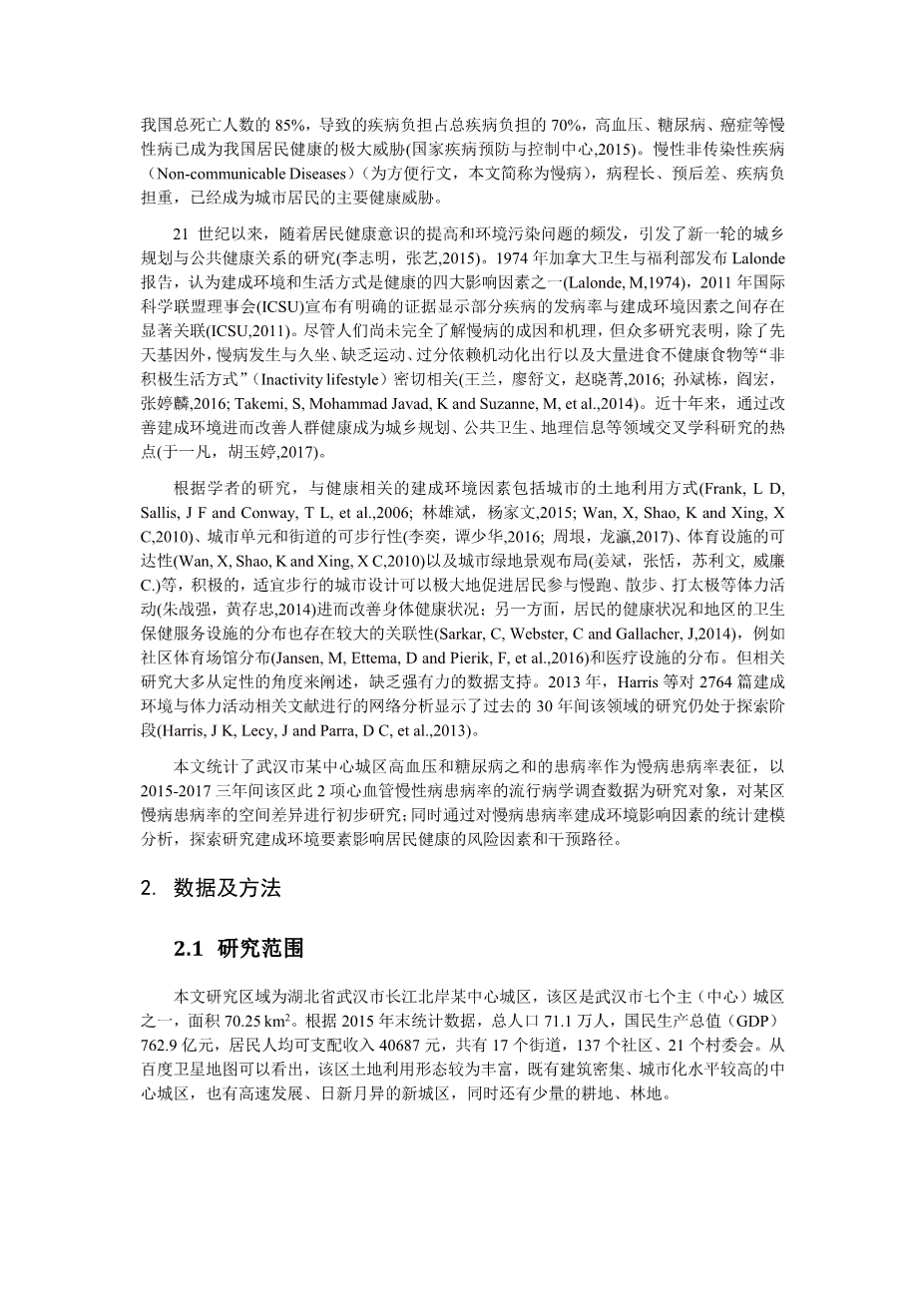

英语原文共 9 页
建成环境慢病风险的量化评价及影响因素分析
——以武汉市某城区为例
Analysis of quantitative evaluation on NCD dangerous factors of built environment cased on Wuhan, China
谢宏杰 杨义平 张栩 张彭
Xie Hongjie, Yang Yiping, Zhang Xu, Zhang Peng
基金项目:武汉市科学技术协会调研课题“健康导向的武汉市宜步指数评测及优化研究”,编号 WHKX201814。 中图分类号:
文献标识码:
【摘要】:城市建成环境是影响居民健康的重要因素,过往研究对于此领域的探索偏于 定性研究,而定量化研究相对匮乏。本研究以武汉市某中心城区 2015-2017 年的慢性病(高 血压和糖尿病之和)患病率作为研究对象,通过对城市单元空间患病率与用地强度、宜步指 数、绿地率以及医疗设施和体育设施可达性等因素进行空间分析,并通过 SPSS 软件进行定 量化实证研究。结果表明:慢性病人群在空间分布上呈现一定的空间聚集性,慢性病患病率 与宜步行指数负相关,与体育和医疗设施的距离成本呈现正相关,而土地利用强度、绿地率 指标未能通过显著性检验。
Abstract: Urban built environment is an important factor which affect humanrsquo;s health. Most of the past research are qualitative research, while quantitative research is relatively scarce. This study used the prevalence of chronic diseases (the sum of hypertension and diabetes) in a certain district which is the one of the central urban area of Wuhan city as a research object, analysis the relationship between the prevalence of chronic disease and built environment factors such as land using intensity, Walkability index, green rate, and medical and sports facilitiesrsquo; accessibility. Then establish a statistical model for empirical research. The results present that the prevalence of chronic diseases showed a certain spatial clustering in urban central areas. The prevalence of chronic diseases was positively correlated with the Walkability index which is unlike the past research in western countries; while sports and medical facilitiesrsquo; accessibility was negatively correlated to it. The land using intensity and green rate failed to pass the significance test.
【关键词】:健康城市;空间分析方法;量化评价;武汉市
Key words: Healthy cities; Spatial analysis approaches; Quantitative assessment; Wuhan city
1. 引言
1.Introduction
随着城市化、老龄化进程加快,以心脑血管疾病、癌症、糖尿病等为代表的非传染性慢 性疾病(NCD,以下简称慢病)患病率呈快速的增长趋势,因慢病导致的死亡人数已经占到
我国总死亡人数的 85%,导致的疾病负担占总疾病负担的 70%,高血压、糖尿病、癌症等慢 性病已成为我国居民健康的极大威胁(国家疾病预防与控制中心,2015)。慢性非传染性疾病
(Non-communicable Diseases)(为方便行文,本文简称为慢病),病程长、预后差、疾病负 担重,已经成为城市居民的主要健康威胁。
With the acceleration of urbanization and aging population, the prevalence of non-communicable chronic diseases, represented by cardiovascular and cerebrovascular diseases, cancer, diabetes etc., shows a rapid growth trend.The number of deaths due to chronic illness has taken up 85% of the total death toll in our country. The burden of disease caused by chronic diseases accounts for 70% of the total disease burden.Chronic diseases such as hypertension, diabetes and cancer have become a great threat to the health of our residents.(according to National Center for Disease Control and Prevention,2015).Non-communicable Diseases, which are long-lasting-period, poor-prognosis and heavy-burden, is becoming main health threat to urban residents.
21 世纪以来,随着居民健康意识的提高和环境污染问题的频发,引发了新一轮的城乡 规划与公共健康关系的研究(李志明,张艺,2015)。1974 年加拿大卫生与福利部发布 Lalonde 报告,认为建成环境和生活方式是健康的四大影响因素之一(Lalonde, M,1974),2011 年国际 科学联盟理事会(ICSU)宣布有明确的证据显示部分疾病的发病率与建成环境因素之间存在 显著关联(ICSU,2011)。尽管人们尚未完全了解慢病的成因和机理,但众多研究表明,除了先 天基因外,慢病发生与久坐、缺乏运动、过分依赖机动化出行以及大量进食不健康食物等“非 积极生活方式”(Inactivity lifestyle)密切相关(王兰,廖舒文,赵晓菁,2016; 孙斌栋,阎宏, 张婷麟,2016; Takemi, S, Mohammad Javad, K and Suzanne, M, et al.,2014)。近十年来,通过改 善建成环境进而改善人群健康成为城乡规划、公共卫生、地理信息等领域交叉学科研究的热 点(于一凡,胡玉婷,2017)。
Since the 21st century, with the improvement of residents #39; health awareness and the frequent occurrence of environmental pollution problems, burst out a new round of research on the relationship between urban and rural planning and public health(According to Zhiming Li, Yi Zhang, 2015).In 1974, the Canadian Department of Health and Welfare released a report, Lalonde, arguing that built environment and lifestyle is one of the four most influential factors for health(Lalonde, M, 1974). In 2011, the International Council of Scientific Unions (ICSU) has announced clear evidence that shows there exists a significant correlation between the incidence of some diseases and the environmental factors of construction(ICSU,2011).Although people are not yet fully understand the causes and mechanisms of chronic diseases, numerous studies have shown that, in addition to congenital genes, chronic diseases are closely related to 'Inactivity lifestyle' such as sedentary, lack of exercise, excessive reliance on motorized travel, and large amounts of unhealthy foods.(Lan Wang, Shuwen Liao, Xiaojing Zhao, 2016; Bindong Sun, Hong Yan,Tinglin Zhang, 2016; Takemi, S, Mohammad Javad, K and Suzanne, M, et al.2014) In the past ten years, improving peoplersquo;s health by improving the built environment has become a hotspot of interdisciplinary research in urban and rural planning, public health and geographic information(Yifan Yu, Yuting Hu, 2017).
根据学者的研究,与健康相关的建成环境因素包括城市的土地利用方式(Frank, L D, Sallis, J F and Conway, T L, et al.,2006; 林雄斌,杨家文,2015; Wan, X, Shao, K and Xing, X C,2010)、城市单元和街道的可步行性(李奕,谭少华,2016; 周垠,龙瀛,2017)、体育设施的可 达性(Wan, X, Shao, K and Xing, X C,2010)以及城市绿地景观布局(姜斌,张恬,苏利文, 威廉 C.)等,积极的,适宜步行的城市设计可以极大地促进居民参与慢跑、散步、打太极等体力活 动(朱战强,黄存忠,2014)进而改善身体健康状况;另一方面,居民的健康状况和地区的卫生 保健服务设施的分布也存在较大的关联性(Sarkar, C, Webster, C and Gallacher, J,2014),例如 社区体育场馆分布(Jansen, M, Ettema, D and Pierik, F, et al.,2016)和医疗设施的分布。但相关 研究大多从定性的角度来阐述,缺乏强有力的数据支持。2013 年,Harris 等对 2764 篇建成 环境与体力活动相关文献进行的网络分析显示了过去的 30 年间该领域的研究仍处于探索阶 段(Harris, J K, Lecy, J and Parra, D C, et al.,2013)。
According to scholars #39; research, health-related built environmental factors, including patterns of land-use in city(Frank, L D, Sallis, J F and Conway, T L, et al.,2006; Xiongbin Lin,Jiawen Yang, 2015; Wan, X, Shao, K and Xing, X C,2010), urban units and walking-availability of street(Yi Li,Shaohua Tan,2016; Yin Zhou,Ying Long,2017), accessabilty of sports facility(Wan, X, Shao, K and Xing, X C,2010), layout of urban landscape and etc. positive and walking-suitable urban design can greatly promote residents to participate in jog
资料编号:[4149]
以上是毕业论文外文翻译,课题毕业论文、任务书、文献综述、开题报告、程序设计、图纸设计等资料可联系客服协助查找。


